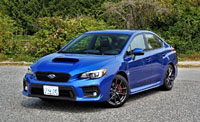
Can a non-price-related case be made for someone actually choosing to purchase the regular WRX over a WRX STI? After a week with the 2019 WRX Sport-tech RS I say yes, and I wasn’t even driving the automatic.
That last point is a clear differentiator between regular WRX and STI, being that the latter can only be had with a six-speed manual gearbox. Therefore, anyone using their WRX as a daily driver, who wants more convenience and relaxation during their commutes, along with the usual high level of performance the WRX has become legendary for, whether blasting up circuitous backcountry roads during weekend road trips or just pushing Gs around freeway cloverleaves on their way to work, can pay a mere $1,300 more to do so with any one of the regular WRX trims, except this particular WRX Sport-tech RS that can only be had with a manual.
To be clear, the WRX Sport-tech can be optioned out with the autobox, but you’ll need to replace the RS suffix from its trim designation with EyeSight. This won’t provide an identical model with different transmissions, but the similarities between the two should be close enough for those seeking a compromise between all-out performance and everyday ease.
Before delving into those similarities and differences, not to mention itemizing features available with the other WRX trims, I wanted to touch on a few details of this very Sport-tech RS tester being reviewed. First off, I was delighted with its coat of World Rally Blue Pearl exterior paint, which while the same as the near identical Sport-tech RS I tested last year, remains a personal favourite colour thanks to its vibrant blue hue and its historical motorsport significance as the base livery of Subaru’s World Rally Championship winning glory years.
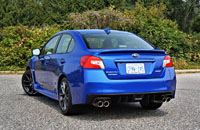
All good and well, but why would Subaru give me a seemingly identical WRX test car within a given year? As I have learned, the company has updated the 2019 WRX infotainment system; the centre-mounted display now becoming one of the most important features in any new vehicle. The first improvement I noticed was the completely redesigned graphic interface, which is much more attractive and now in line with other updated models across the Subaru lineup (new 2020 Outback and Legacy aside). It’s highlighted by colourful smartphone/tablet-style circular candy drop digital buttons surrounded by squarish floating tiles on a star-speckled night sky-like deep blue 3D background, an attractive image for sure, while Apple CarPlay and Android Auto phone integration are now part of both the base and top-tier systems.
Our tester comes standard with the latter, the touchscreen still measuring 7.0 inches diagonally for a half-inch gain over the base display, and once again getting touch-sensitive quick access buttons down each side, which include Home, Map and Apps to the left and Info just above two sets of track seeking arrows on the right. The system also includes near-field communication (NFC) for faster phone connectivity (if your smartphone offers it), a Micro SD card slot, HD radio, new glossy black topped audio knobs, navigation mapping and routing, a rearview camera with dynamic guidelines, plus more. I find this new interface much easier to use, while the display’s clarity and depth of colour is excellent, easily matching the best in the mainstream business, and surpassing many.
As for the rest of this WRX Sport-tech RS and its non-STI compatriots, they remain unchanged for 2019, meaning this model still features last year’s extensive styling updates, chassis improvements, and other refinements, not to mention the a safety feature. Let me go into more detail.
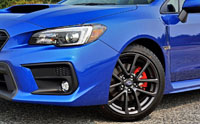
Regarding styling, Subaru reworked the WRX front grille and bumper design for 2018, as well as the door trim inside, while a new electroluminescent primary gauge cluster boasting a really attractive high-resolution colour TFT centre display was added too. Additionally, the 5.9-inch colour multi-information dash-top display received new graphics that look fabulous. This sporty interface, which pays homage to the secondary ancillary turbo, temp and oil pressure analogue gauges of past performance cars in both its placement and functionality within, is also completely unique in this class, adding that special custom allure to the WRX that’s missing from many rivals.
What’s more, rear passengers continue to benefit from last year’s new fold-down centre armrest with integrated cupholders, while all occupants can now enjoy easier conversations thanks to better insulation and other refinements that result in reduced noise, vibration and harshness levels, plus an improved ride from a retuned suspension setup, and lastly the car is made better overall from a stronger battery.
While all of the above are obvious improvements, I personally really like the new grille design too, especially its blackened borders and black mesh insert, plus the racing-spec-style multi-component lower front fascia with its matte black centre vent looks menacingly intimidating, just like a formidable sport sedan should, as do the larger, squarer matte black fog lamp bezels. Lastly, this Sport-tech RS model’s twinned five-spoke gunmetal grey-painted cast aluminum alloys on 245/40 Dunlop SP Sport Maxx RT performance tires framing red brake calipers look superb—base and Sport models come fitted with grey 15-spoke 17-inch alloys on the same tires measuring 235/45.
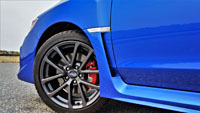
All of the above, combined with everything else upgraded last year, like the massive hood scoop, redesign headlamps, and race-inspired matte black rear diffuser with quad chromed tailpipes, plus everything that appears to mostly be pulled forward from the 2015 through 2017 version, such as the coke-bottle fenders with integrated engine vents bearing chromed “WRX” appliques, subtle rear deck lid spoiler (that I like much more than the STI’s gigantic wing—the smaller lip spoiler can be had with the STI too), etcetera, look fabulous.
Also carryover (but who’s complaining), non-STI WRX variants once again include Subaru’s brilliant 2.0-litre direct-injection twin-scroll turbocharged boxer four, making a healthy 268-horsepower and 258 lb-ft of torque. That’s getting pretty close to the STI’s 310 horsepower and 290 lb-ft of torque, and considering you can get into the former for just $29,995 plus freight and fees, or $38,995 as tested, which is much more affordable than the latter model’s $41,995 base price, or the more comparable $47,295 STI with its Sport-tech package, the regular WRX starts to look like a very smart choice. Then factor in that most of its similarly priced challengers don’t measure up with respect to performance, while also not offering Subaru’s standard Symmetrical-AWD (or any AWD at the WRX’ price point), and it makes a sound case to Canadian performance enthusiasts.
As noted, connecting engine to driveline is a standard as-tested six-speed manual, but many are not aware that the optional automatic is actually a continuously variable transmission (CVT), the bane of gearheads everywhere. This said, CVTs have come a long way in recent years, and Subaru’s Sport Lineartronic design is quite impressive thanks to quick-shifting steering wheel paddles that prod both six- and eight-speed manual modes, plus the benefit of Subaru Intelligent Drive (SI-DRIVE). I know, it’s difficult to hear the words WRX and CVT being used in the same sentence, let alone learn they’re being incorporated into the same car, but after testing one in 2017 I was positively surprised. This doesn’t mean I’d opt for one if my personal money was on the line, but I certainly wouldn’t criticize anyone for choosing to.
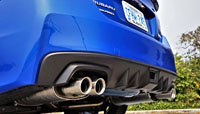
More importantly to WRX purists, the manual gearbox I tested received a new shift lever along with improved shifter and clutch feel as part of last year’s redesign, and the former remains as wonderfully smooth and accurate as last year’s update made it, while clutch weight is ideal and take-up more responsive without being grabby.
As you may have guessed, there’s no change in straight-line acceleration from the identically powered 2018 model, with the manual still good for a claimed zero to 100km/h run of 5.4 seconds, and the CVT capable of achieving the same feat in a respectable 5.9 seconds. Neither time is the stuff of legend, of course, but I can’t see many driving enthusiasts being underwhelmed with the regular WRX’ off-the-line performance, while those that opt for the CVT will surprisingly own bragging rights to the fastest top speed specs, the autobox adding 8 km/h to the manual’s terminal velocity with a nice round total of 240 km/h compared to 232.
As I said last year, most modifications were about refinement, and included improved steering feel and a more compliant ride that doesn’t compromise at-the-edge handling. Being that my aging body appreciates having a bit more comfort now than when younger, as is the case for many WRX owners, this friendlier suspension setup is a very good thing. It was during regular errand runs around town that I most appreciated the improvements, yet when opportunity provided an empty lane on a winding rural road the new WRX’ firmly damped fully independent suspension remained as resolute to pavement as it’s always been, especially over broken and uneven tarmac that didn’t unsettle the chassis one iota.
While WRX performance is commendable, those seeking out a four-cylinder compact model for fuel-efficiency can only take a modicum of solace in a Transport Canada rating that’s only better than the STI’s 14.3 L/100km city, 10.7 highway and 12.7 combined rating, because with a claimed rating of 12.6 L/100km city, 9.6 highway and 11.2 combined when mated to its standard manual gearbox, or 11.3, 8.5 and 10.0 respectively with the CVT, it’s not exactly the thriftiest sport model in its compact class. In fact, plenty of more powerful alternatives deliver much better economy, yet fortunately for Subaru this is hardly the priority of most WRX buyers.
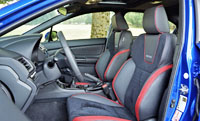
Now that we’re talking practicalities, the WRX remains a pragmatist’s sports car. It’s capable of seating four to five in comfort, plus houses plenty of life’s gear in its 340-litre (12-cubic-foot) trunk, plus more when expanding its 60/40 split-folding rear seatbacks. Also, a trunk provides a great deal more security than available to the WRX’ hot hatch competitors that are more susceptible to break and entry crime.
I was once again impressed by the WRX’ interior quality too. For instance, its instrument panel is wholly formed from premium soft-touch synthetic, across the very top of the dash and all the way down to the halfway point of the centre stack, while the door uppers are comfortably pliable from front and back as well, plus filled with cushion-backed leather-like inserts and padded armrests, that were all stitched in red no less.
Red in mind, I like that Subaru took the tasteful route when highlighting the WRX interior, unlike some of its less experienced rivals that look as if their red embellishments were smeared on by a tweenager over-applying rouge and lip gloss (Civic Type R, I’m talking to you). The WRX Sport-tech RS model’s just noted red stitching also covers the door inserts, steering wheel rim, shifter boot, and bolsters of the seats that are also emblazoned with a thick strip of red leather, which is a nice contrast to the black leather and microsuede material found elsewhere. Lastly, a stylish circle of red piping wraps around the centre of the seat like a frame for the white embroidered “RECARO” logo, this nicely matching the red piping around the headrest just above. The interior’s finishing touch is a splash of carbon-fibre style trim across the dash.
Most of what I’ve just described is specific to the Sport-tech RS as noted, which incidentally was new last year, but keep in mind there are plenty of other WRX trims worth investigating. Along with the sub-$30k base model and $39,095 Sport-tech EyeSight already mentioned, Subaru offers $33,195 Sport trim and a Sport-tech without the $2,300 RS upgrade for $36,495.
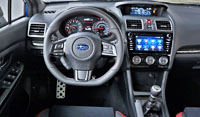
Additionally, a special $40,995 雷雨 Raiu Edition was added for 2019, featuring one really attractive exclusive Cool Grey Khaki colour. It adds a number of STI-style exterior details such as a sharper front lip spoiler, extended side skirts and a much larger rear wing spoiler, plus big 19-inch alloys encircling the STI’s yellow-painted Brembo six-pot front and two-pot rear brake calipers over ventilated and cross-drilled rotors. Some additional 雷雨 Raiu Edition features include the Subaru Rear/Side Vehicle Detection System (SRVD) that incorporates blindspot monitoring with rear cross-traffic alert and lane change assist, plus it also gets a powered moonroof, a 10-way powered driver’s seat including lumbar, the same ultrasuede-enhanced sport seats as in the RS, plus red seatbelts.
Incidentally, all 2019 WRX trim, package and option prices were sourced right here on CarCostCanada, where you can also find important info on manufacturer rebate programs and otherwise hard to find dealer invoice pricing that could actually save you thousands of dollars. Make sure to check this out thoroughly before you buy.
Specific to the WRX Sport-tech RS tested here, a set of uprated Jurid brake pads clamp down on a standard set of 316 mm front and 286 mm rear rotors via the red brake calipers noted earlier, while the cabin features the luxurious black and red partial-leather/ultrasuede upholstery also mentioned before (ad nauseum), while the driver’s seat is downgraded from 10-way power to just eight adjustments due to the much more inherently supportive Recaro sport seats that my backside happened to love.
On top of this, my tester’s Sport-tech RS trim added proximity-sensing keyless access with pushbutton ignition, the larger 7.0-inch centre touchscreen filled with the updated system graphics noted earlier, plus Subaru’s StarLink app, additional apps such as Yelp, Best Parking, Glympse, SiriusXM Traffic and Travel Link with weather, sports and stock market info, and a 320-watt nine-speaker Harman/Kardon audio system that sounded awesome, plus two USB ports.
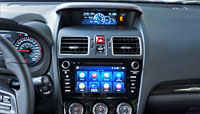
Items pulled up from Sport trim include wiper-integrated automatic LED headlights with new steering-responsive cornering, LED fog lamps, LED turn signals integrated within the side mirror housings, welcome lighting, a tastefully discreet rear deck lid spoiler, plus the aforementioned powered glass sunroof and SRVD blindspot safety upgrade.
Lastly, base model features pulled up to Sport-tech RS trim include a quad-tipped high-performance exhaust, integrated roof rack brackets, a windshield wiper de-icer, a well-designed leather-wrapped and red-stitched multifunction flat-bottom sport steering wheel, single-zone automatic climate control, heatable front seats, StarLink smartphone integration (including Aha radio), a backup camera, AM/FM/CD/MP3/WMA audio, satellite radio, Bluetooth phone connectivity with audio streaming, aux and USB ports, voice activation, and more.
While Sport-tech RS trim doesn’t come standard with Subaru’s EyeSight suite of advanced driver assistive systems, I need to mention exactly what this is just in case you want your WRX with as much active safety and convenience as possible. As noted, you can upgrade the WRX Sport-tech with EyeSight, and when you do it becomes one of the most technologically forward-thinking cars in its class, thanks to automatic high beams, adaptive cruise control, lead vehicle start alert, pre-collision braking, pre-collision brake assist, pre-collision throttle management, reverse automatic braking, lane departure warning, lane sway warning, and lane keeping assist.
So equipped the WRX earns a best-possible IIHS Top Safety Pick + rating, the “+” rather hard to get in the small car class and only shared with three other brands, none of which compete directly with the WRX. Even more impressive, Subaru has four models that can be equipped to meet this high grade of advanced safety, more than any other automaker in the small car segment.
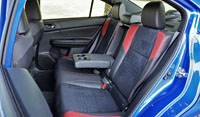
Even better, Subaru has more IIHS Top Safety Pick + rated vehicles than any other mainstream volume manufacturer, including more mid-size models with the coveted safety rating, and the same status for every vehicle it produces other than the Toyota co-designed/built BRZ, for a total of eight models. No other brand even comes close, with Toyota only elevating two of its models to this rarified height, Honda just one, and Nissan with none. This, when combined with the extra all-weather safety provided by these models’ standard Symmetrical all-wheel drive, is as good as it gets.
So while the WRX isn’t exactly a leader in fuel-efficiency, it’s ahead of the pack in almost every other way, and makes a strong case for itself when compared to its key performance-focused competitors as well as when put up against the pricier STI. If money were no object my choice would be the latter, but I can totally understand why someone might feel compelled to choose a regular WRX, especially when it’s as nicely equipped as this Sport-tech RS.
Story credit: Trevor Hofmann
Photo credit: Karen Tuggay
